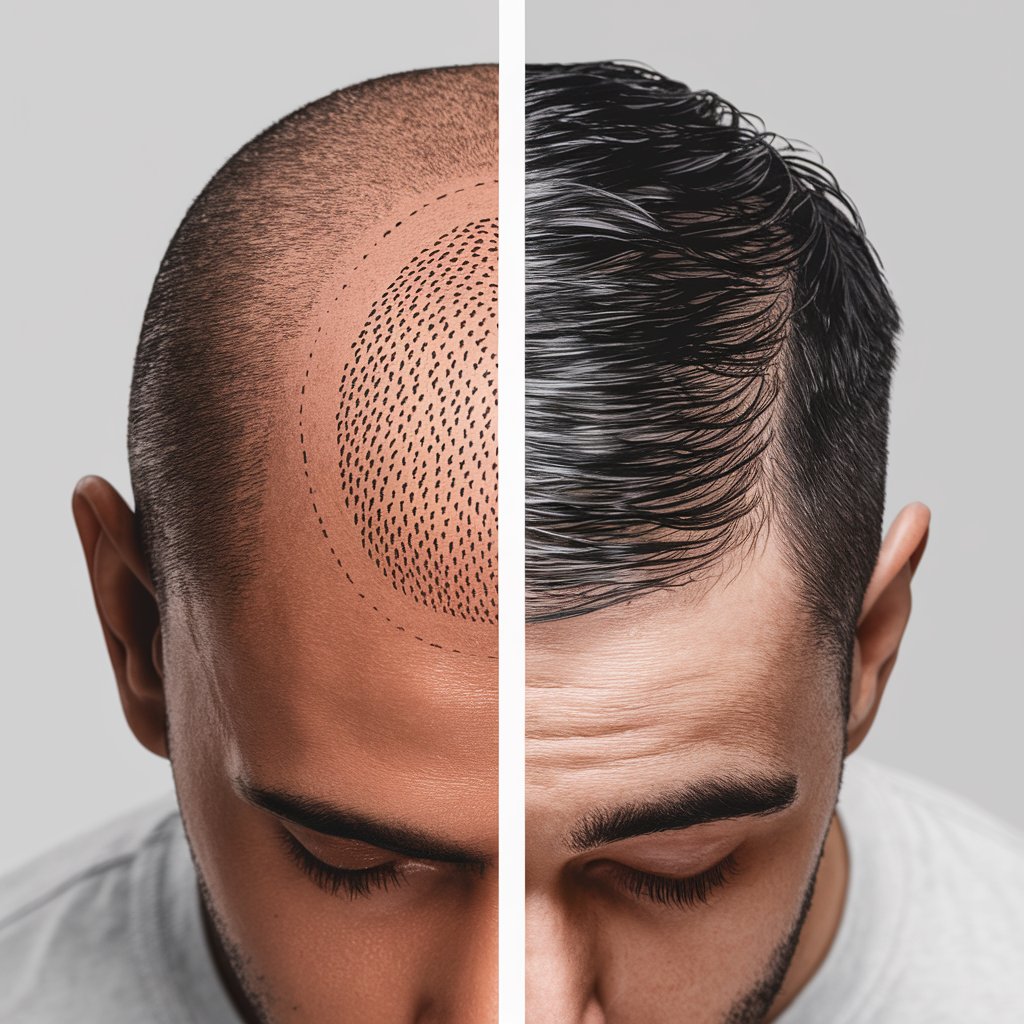Can Hair Loss Be Reversed?
Reversing Hair Loss: A Journey to Renewed Confidence
Hair loss can be more than just a cosmetic concern—it often impacts self-esteem and personal identity. For those struggling with thinning hair or bald patches, the quest to reverse or slow down hair loss can seem daunting. Fortunately, modern medicine and technology offer a range of solutions, from topical treatments to advanced therapies and surgical interventions. But with so many options available, how do you determine the best path forward? In this comprehensive guide, we’ll explore the various treatment options for hair loss, including medications, non-surgical treatments, and surgical procedures. We’ll also discuss the factors that influence the effectiveness of these treatments, helping you navigate the complex world of hair restoration. Whether you’re looking to prevent further loss or seeking ways to regain a fuller head of hair, understanding these options can empower you to make informed decisions on your journey to renewed confidence.
Treatment Options for Hair Loss: Exploring Effective Solutions
Hair loss is a common issue that affects millions of individuals worldwide, and while it can be challenging, various treatments offer hope for those seeking to reverse or manage their condition. Here’s a closer look at the most prominent options available today:
Medications: For many, medications provide a non-invasive means of addressing hair loss, particularly androgenetic alopecia, commonly known as pattern baldness.
- Minoxidil (Rogaine): This over-the-counter treatment is widely used to combat hair loss. Applied directly to the scalp, Minoxidil helps to stimulate hair follicles and can lead to regrowth or slowed hair loss. Results typically appear after several months of consistent use. While effective for many, it’s important to note that not everyone will experience significant regrowth.
- DHT Blockers: Finasteride (Propecia) is a prescription medication that works by inhibiting the conversion of testosterone to dihydrotestosterone (DHT), a hormone linked to hair loss. By reducing DHT levels, Finasteride helps maintain existing hair and can stimulate regrowth in some individuals. It’s crucial for users to discuss potential side effects with their healthcare provider, as the medication can impact sexual health in some cases.
Hair Transplant Surgery: For those experiencing more advanced hair loss, surgical interventions can provide a more permanent solution.
- Follicular Unit Extraction (FUE): This method involves harvesting individual hair follicles from a donor area, typically the back or sides of the head, and transplanting them to thinning or balding areas. FUE is known for its minimal scarring and natural-looking results, making it a popular choice among patients seeking a less invasive surgical option.
- Follicular Unit Transplantation (FUT): Also known as the strip method, FUT involves removing a strip of scalp from the donor area, dissecting it into individual follicular units, and then transplanting these units to the recipient site. While FUT can be effective and offer high-density results, it may leave a linear scar, which some patients find less desirable.
Each of these treatments has its advantages and considerations, making it important to consult with a healthcare professional or hair restoration specialist to determine the most suitable approach based on individual needs and hair loss patterns.
Non-Surgical Treatments: Alternative Approaches to Hair Restoration
For those seeking less invasive options to address hair loss, non-surgical treatments offer promising alternatives. These methods can help stimulate hair growth and improve hair density without the need for surgical intervention. Here’s a closer look at some of the leading non-surgical treatments:
Low-Level Laser Therapy (LLLT):
Low-Level Laser Therapy uses specific wavelengths of light to stimulate hair follicles and promote hair growth. This non-invasive treatment aims to increase blood flow to the scalp, enhance cellular activity, and encourage the growth of new hair. LLLT devices, such as laser combs and helmets, are available for both in-office treatments and home use. Many users report improvements in hair density and thickness with consistent use, although individual results can vary.
Platelet-Rich Plasma (PRP) Therapy:
PRP therapy is a cutting-edge approach that leverages the healing properties of platelets in your own blood to stimulate hair growth. The process begins with drawing a small amount of blood from the patient, which is then processed to concentrate the platelets. This concentrated plasma is injected into the scalp, targeting areas of thinning or baldness. PRP therapy is believed to enhance hair follicle function and promote the natural growth cycle of hair. While many patients see positive outcomes, it may require multiple sessions to achieve optimal results.
Microneedling:
Microneedling involves using a device equipped with fine needles to create micro-injuries in the scalp. These tiny punctures stimulate the body’s natural healing response and increase the absorption of topical treatments. This technique is often combined with other therapies like Minoxidil or PRP to enhance their effectiveness. Microneedling can help improve hair thickness and density, although it typically requires several sessions for noticeable results.
Topical Treatments:
In addition to Minoxidil, there are other topical treatments available that can help manage hair loss. These products often contain ingredients like caffeine, biotin, or peptides, which are believed to support hair growth and strengthen existing hair. While these treatments can be effective for some individuals, their success often depends on consistent application and individual response.
Non-surgical treatments offer a range of options for those looking to address hair loss without undergoing surgery. Exploring these alternatives can help individuals find a solution that fits their needs and lifestyle, while potentially providing significant improvements in hair growth and density.
Factors Influencing Hair Loss Reversal: Key Considerations
When evaluating the potential for reversing hair loss, several factors play a crucial role in determining the effectiveness of treatments. Understanding these factors can help you tailor your approach and set realistic expectations. Here’s a look at the key elements that influence the success of hair loss reversal:
Type of Hair Loss:
- Androgenetic Alopecia: Commonly known as pattern baldness, this hereditary condition is characterized by gradual thinning and loss of hair. Treatments like Minoxidil, Finasteride, and hair transplant surgery are often effective in managing androgenetic alopecia, especially when started early.
- Alopecia Areata: This autoimmune condition causes sudden, patchy hair loss. In some cases, hair regrows spontaneously without treatment. However, therapies like corticosteroids and PRP can help stimulate regrowth in more persistent cases.
- Telogen Effluvium: Often triggered by stress, hormonal changes, or illness, telogen effluvium leads to diffuse hair shedding. Addressing the underlying cause and using treatments that promote overall scalp health can help reverse this type of hair loss.
Timing of Treatment:
Early intervention is crucial for reversing or slowing down hair loss. The sooner you begin treatment after noticing signs of hair thinning or loss, the better the chances of achieving positive results. Early treatment can prevent further hair loss and, in many cases, promote the regrowth of hair in thinning areas.
Individual Response:
Each person’s response to hair loss treatments can vary based on several factors, including genetics, overall health, and adherence to treatment protocols. While some individuals may experience significant improvement with a particular treatment, others may see more modest results. It’s important to work closely with a healthcare professional to monitor progress and adjust the treatment plan as needed.
Lifestyle and Health Factors:
Overall health and lifestyle choices can impact the effectiveness of hair loss treatments. Maintaining a balanced diet, managing stress, and avoiding harsh hair care practices can support hair health and enhance the results of any treatment. Additionally, addressing any underlying health conditions that may contribute to hair loss can improve the likelihood of successful reversal.
By considering these factors, you can better understand how to approach hair loss treatments and maximize their effectiveness. Consulting with a hair restoration specialist can help you develop a personalized plan tailored to your specific needs and conditions.
Conclusion: Navigating the Path to Hair Loss Reversal
The journey to reversing hair loss is multifaceted, involving a range of treatments and considerations that can impact the effectiveness of each approach. From medications and non-surgical therapies to surgical interventions, there are various paths to explore, each offering its own benefits and limitations.
Medications such as Minoxidil and DHT blockers can provide effective solutions for many, slowing or even reversing hair loss, particularly when used early. Non-surgical treatments like Low-Level Laser Therapy (LLLT) and Platelet-Rich Plasma (PRP) Therapy offer additional options for stimulating hair growth without the need for invasive procedures. For those with more advanced hair loss, hair transplant surgeries such as Follicular Unit Extraction (FUE) and Follicular Unit Transplantation (FUT) present permanent solutions that can yield natural-looking results.
However, the success of these treatments often hinges on several factors, including the type of hair loss, the timing of intervention, individual response, and overall health. Understanding these factors can help set realistic expectations and guide you toward the most suitable treatment plan.
Ultimately, while not all hair loss can be fully reversed, many effective treatments are available that can significantly slow the process or promote regrowth. Consulting with a healthcare professional or a hair restoration specialist is essential for devising a personalized approach tailored to your specific needs and conditions.
By staying informed and proactive, you can take meaningful steps toward managing hair loss and enhancing your overall confidence and quality of life.

